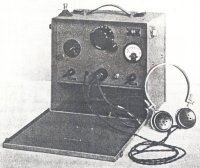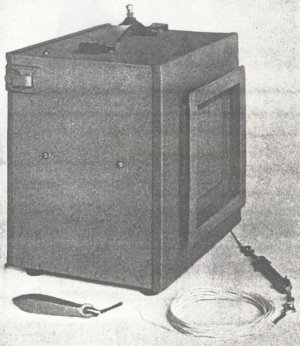
AWA FS11
| VK2DYM'S MILITARY RADIO AND RADAR INFORMATION SITE. |

AWA FS11
A number of Australian radio sets used in WW2 were adapted from commercial products. One such was the ATR4 which derived from the commercial RC16 by Radio Corporation in Melbourne.
In Sydney, AWA produced a small portable set that was a direct competitor to the RC16 but it saw only limited war service. It is however interesting to compare it with the RC16/ATR4 and the WS No.108 and WS No. 208.
In early 1941 AWA designed the FS11 or Field Set No. 11, to be a small battery operated portable set specifically intended for the Flying Doctor Service. The intention was that the set could be carried in an aircraft and used on the ground to keep in contact with the base stations when at an outlying property or in the event of an emergency landing.
The set was CW transmit only but could receive either voice or CW. It was powered by a 144V HT battery, a 3V LT battery and a -6V "C" Bias battery for the transmitter. On continuous receive, the HT battery was expected to last around 35 hours and the LT battery around 12 hours. The power output was approximately 0.4 watts into a 300 ohm resistive load.
The set covered 5.1 to 6.85 Mc/s on receive and was crystal controlled on the Flying Doctor frequency of 6540 Kc/s for transmit. The IF frequency was 455 Kc/s.
The set was built into a metal case with a fold down hinged front cover. The radio was housed in an upper compartment and secured by two large hex headed screws on the sides. In a lower compartment were the batteries, key and headphones. Interestingly, both the morse key and headphones were permanently connected to the set. At least that way it was harder to lose them!

AWA FS11. The plug for the battery cable (centre) had to be removed in order to close
the lid.
The controls were:
RECEIVER
TUNING dial which covered 5.1 to 6.85 Mc/s, with a vernier knob on the
bottom right.
AWA NAMEPLATE. The FS11 had the AWA internal designation of J6702.
RECEIVE CW - RECEIVE PHONE - OFF - SEND Control Switch.
POWER AMPLIFIER meter.
AF GAIN control.
HEADPHONE connection. The headphones were permanently connected to the
set.
BATTERY SOCKET. The battery plug had to be removed in order to close the
lid, to obviate leaving the power on. The morse key was permanently connected
via the battery cable plug.
COUNTERPOISE TERMINAL. A 12 ft. length of wire was used as a
counterpoise.
TUNE control. A variable condenser in series with the aerial allowed the
transmitter to be tuned for maximum deflection on the meter.
On the top left corner of the case is the aerial terminal.
The antenna consisted of an insulated wire about 40 ft. long (1/4 wave at 6540 Kc/s) and was carried wrapped around a metal flange welded to the back of the case. The aerial wire had an insulator and then a length of throwing line with a lead weight attached so that it could be strung over a tree branch etc.
 |
 |
| FS11 rear view, showing the aerial insulator, throwing line and lead weight. The long wire antenna wrapped round the flange on the back of the case. | FS11 in its carrying satchel. Complete with batteries, key and headphones it weighed less than 23 Lbs. |
The specifications of the FS11 are as follows:
| SENDING (ma.) | RECEIVING (ma.) |
| LT | HT | LT | HT | |
| Current Consumption | 360 | 12 | 600 * | 17 |
| WEIGHT (lbs) | LENGTH (in.) | WIDTH (in.) | HEIGHT (in.) | |
| FS11 | < 23 (in satchel) | 11 | 9 | 10 1/2 |
* The LT current on receive seems high at 600ma but that is what is given in the description.
The
valve line up was:
RECEIVER
V1
1C7G Converter
V2
1K5G IF Amplifier
V3
1K7G 2nd IF, 2nd Detector, AVC
V4
1K7G Audio Amplifier
V5
1C7G BFO
TRANSMITTER
V6
1K3G Crystal Oscillator
V7
1L3G Power Amplifier
AWA made a number of different sets with the FS designation. The quantity produced may have been very small if orders were not forthcoming from customers. In fact the FS11 may never have progressed past a few prototypes and test sets. As the RC16 was also supplied with the Flying Doctor crystal on 6540 Kc/s and is far more numerous I assume that it won more orders than the FS11. The best known of the AWA FS series is the FS6 which was widely used in WW2.
References.
AWA Technical Review, Volume 5, No. 5, 1941 "A Portable Wireless Set for
the Flying-Doctor Services."
Please note, this article is copyrighted.